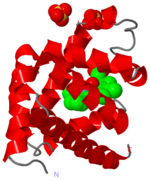User:Michael Roberts/BIOL115 Myo
From Proteopedia
(Difference between revisions)
| Line 20: | Line 20: | ||
This next view simplifies things, and just shows a <scene name='User:Michael_Roberts/BIOL115_Myo/Secondary_structure/9'>cartoon representation </scene>of the secondary structure of the protein. | This next view simplifies things, and just shows a <scene name='User:Michael_Roberts/BIOL115_Myo/Secondary_structure/9'>cartoon representation </scene>of the secondary structure of the protein. | ||
| - | You see how the <scene name='User:Michael_Roberts/BIOL115_Myo/Hbonds/1'>hydrogen bonds</scene> that maintain the main secondary structure of the protein are arranged in this next view. | + | You see how the <scene name='User:Michael_Roberts/BIOL115_Myo/Hbonds/1'>hydrogen bonds</scene> (yellow) that maintain the main secondary structure of the protein are arranged in this next view. |
| + | Some amino acids have specific effects on secondary structure. This next view shows the locations of the <scene name='User:Michael_Roberts/BIOL115_Myo/Secondary_structure/11'>PROLINE</scene> residues in myoglobin. You can see that they all fall at the end of a stretch of helix. This is bacause their large side chains do not fit within the straight run of α-helix. | ||
'''THE GLOBIN FOLD''': | '''THE GLOBIN FOLD''': | ||
Revision as of 10:50, 15 April 2013

Crystal Structure of myoglobin, 1a6m
The heme group and oxygen binding in myoglobin.
Myoglobin is a protein whose function is to store oxygen in muscle tissues. Like heamoglobin, it is red in colour, and it is myoglobin that gives muscle its strong red colour.
Myoglobin was the first globular protein for which the 3-dimensional structure was solved, back in the late 1950s. It gives its name to the 'globin fold', a common alpha domain motif. An alpha domain is a structural region composed entirley of alpha-helix.
Click on the 'green links' in the text in the scrollable section below to examine this molecule in more detail.
| |||||||||||
